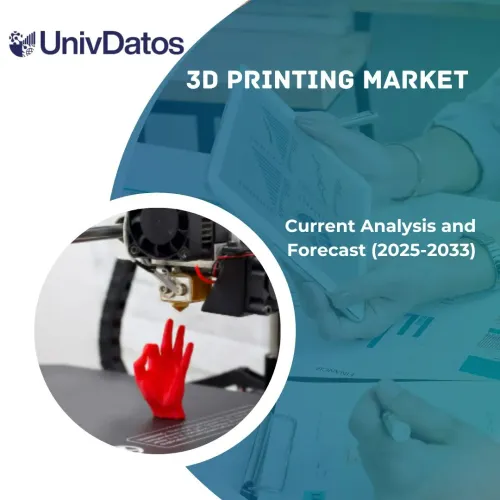- Home
- About Us
- Industry
- Services
- Reading
- Contact Us
Asia Pacific 3D Printing Market: Insights and Forecast (2018-2024)
Emphasis on Component ((Product (Professional/Industrial Printer, Personal/Desktop 3D Printers), Material (Polymer, Plastic, Metals and Alloys, Ceramic, Other Materials), Technology ( Stereolithography, Selective Laser Sintering, Electron Beam Melting, Fused Deposition Modelling, Laminated object Manufacturing, Other Technologies))
Asia Pacific industries have become the leaders in using digital technology and are now ahead of the curve in embracing new technologies contradicting the adoption rate of its counterparts. Asia Pacific region scores higher since manufacturing businesses are adopting and incorporating innovations in technology from drones to 3D printing. Digitization has successfully enabled Small and Medium enterprises to use new technology to catch up to bigger rivals and allows them to grow and scale up their business while reducing costs. 3D printing purposes to transform the future of Asia Pacific manufacturing industry. It has been further estimated that expenditure on 3D printing in Asia Pacific will cross US 3 Billion by 2021. Asia Pacific 3D printing market is expected to register CAGR of 28.4% over the forecasted period and is estimated to reach US XX million by 2024.
The market for additive manufacturing in Asia Pacific has grown considerably primarily accredited to rising research and development initiatives, manufacturing disruption and surge in regulatory support by government bodies. However, high rate of unemployment, lack of technological understanding in 3D printing and designing environment unconducive for experimentation pose as some of the bottlenecks in the growth potential of Asia Pacific 3D printing market. As the global manufacturing digitally transforms, businesses aim to divert themselves where 3D printing is fully embraced with developed ecosystem, is equipped with highly skilled workforce in 3D Printing and has appropriate research and development facilities. Conducive environment is anticipated to create strong customer base that can propel the demand for 3D printing and further enhance the initiatives for research and development comprising of government support and incentives.
Asia Pacific 3D printing has stimulated its spending within the various areas of 3D printing domain comprising of 3D printers (hardware), 3D printing materials paired burgeoning expenditure in various industry verticals. It has been estimated that industrial manufacturing dominated in 3D printing with spending valued at US$ 1 Billion during 2018 and is further anticipated to reach beyond US$ 1.5 Billion by 2021. Although hardware component generated the largest revenues in the past few years, the focus on material components is also anticipated to drive the future spending towards the respective technique. In addition, service segment will continue to remain the key contributor of the market. In addition, education and health care is also projected to display the drastic growth in 3D printing wherein learning or research activities and printing of dental objects, surgical models are projected to dominate in near future.
Insights Presented in the Report:
- The report analyses 3D Printing market report majorly based on component, technology, applications and end users. Products, materials and services are the major components considered in the deep analysis of the 3D printing industry.
- Product segment is further classified into professional printers and desktop printers. Product segment is expected to register fastest growth, owing to increasing demand for desktop 3D printers over the period of time although industrial printers is projected to continue to display its dominance till 2024.
- Asia Pacific 3D printing material market is further divided into different material types including polymer, plastic, metal and alloys, ceramics and others materials. In 2017, polymer segment dominated the Asia Pacific 3D printing material type market as they represent greatest penetration and user accessibility in 3D printing.
- Stereolithography, Selective Laser Sintering, Electron Beam Melting, Fused deposition modeling, Laminated object Manufacturing and Others are the major technologies considered while analyzing the regional 3D printing market. Fused Deposition Modelling, Selective Laser Sintering and Stereolithography constitute as the topmost technologies in 3D printing. Fused Deposition Modelling occupied the prominent share in 2017 as it is one of the prominent and user friendly technology that is widely used to create 3D printed objects.
- Based on application type, Asia Pacific 3D printing market is bifurcated into functional parts, fit and assembly, prototype modelling, education, metal casting, Visual Aids, Presentation Modelling and other applications. Functional parts captured maximum share during 2017 owing to its fast speed, quality and low cost of additive manufacturing.
- Furthermore, 3D printing techniques find its major application in verticals such as education, automotive, aerospace & defense, healthcare, consumer goods, manufacturing, construction and others. Manufacturing sector dominated 3D printing landscape during 2017 owing to bolstering digitalization wherein 3D printing solutions have paved way for manufacturing companies.
- For better understanding of the geographical penetration of 3D printing market in Asia Pacific, the market is analyzed based on its outreach in the countries such as China, Japan, India, Singapore, Australia, South Korea and rest of Asia Pacific. Japan and China altogether majorly constitute as force behind the boom of 3D printing in Asia Pacific owing to Chinese government support in terms of 3D printing strategies and fiscal support. Moreover, China also aims to invest US$ 240 Million in next few years with an objective to boost development of 3D printing technique in China. Moreover, influx of numerous players in 3D printing and technological advancements and research in Japan has further contributed both these countries to become the leading ones in 3D printing domain. Hence, projected consumer trends and innovation investments will propel 3D printing demand and supply in Asia Pacific region. Japan 3D printing market was valued at US$163.5 Million during 2017.
- Key companies profiled in the report 3D Systems Corporation, Arcam AB, Royal DSM N.V., Stratasys Ltd., Autodesk, Inc., The ExOne Company, Hoganas AB, Organovo Holdings, Inc, Mcor Technologies Limited and Voxeljet AG. With the significant potential lying in 3D printing domain, there lays immense potential for industries to reinvent themselves via digital transformation of production. For instance, recently in 2018, BASF has expanded into 3D printing market in Asia Pacific region which can vastly accelerate development and production of complex 3D products.
Reasons to buy the Report:
- The study includes market sizing and forecasting analysis validated by authenticated key industry experts
- The report presents a quick review of overall industry performance at one glance
- The report covers in depth analysis of prominent industry peers with primary focus on key business financials, product portfolio, expansion strategies and recent developments
- Detailed examination on drivers, restraints, key trends and opportunities prevailing in the industry.
- Examination of industry attractiveness with the help of Porter’s Five Forces analysis
- The study comprehensively covers the market across different segments
- Deep dive regional level analysis of the industry
Customization Options:
The Asia-Pacific 3D Printing Market can be customized to the country level or any other market segment. Besides this, UMI understands that you may have your own business need, hence we also provide fully customized solutions to clients.
Table of Content
Analysing historical market, estimation of the current market and forecasting the future market for Asia-Pacific 3D Printing market were the three major steps undertaken to create and analyse the overall adoption of 3D Printing in major Asian countries. Exhaustive secondary research was conducted to collect the historical market of the product/technology and overall estimation of the current market. Secondly, to validate these insights, numerous findings and assumptions were taken into consideration. Moreover, exhaustive primary interviews were conducted with industry experts across value chain of the Asia-Pacific 3D printing industry. After all the assumption, market engineering and validation of market numbers through primary interviews, top-down approach was employed to forecast the market size of 3D Printing in the Asia-Pacific region to 2024. Thereafter, market breakdown and data triangulation methods were adopted to estimate and analyse the market size of segments and sub-segments of the market. Detailed research methodology is explained below:
Analysis of Historical Market Size
Step 1: In-Depth Study of Secondary Sources:
Detail secondary study was conducted to obtain the historical market size of the Asia-Pacific 3D Printing market through company internal sources such as annual report & financial statements, performance presentations, press releases, sales figures etc. and external sources including journals, news & articles, government publications, competitor publications, sector reports, third-party database and other creditable publications.
Step 2: Market Segmentation:
After obtaining historical market size of the overall market, detailed secondary analysis was done to gather historical market insights and share for different segments & sub-segments for the Asia-Pacific 3D Printing. Major segments included in the report are component, technology, application and end-user.
Step 3: Factor Analysis:
After acquiring the historical market size of different segments and sub-segments, detailed factor analysis was conducted to estimate the current market size of the Asia-Pacific 3D Printing industry. Factor analysis was conducted using dependent and independent variable such as purchasing power, player initiatives, penetration of 3D printing, government regulations in different regions. Historical trends of the 3D Printing and their year-on-year impact on the market size and share in the recent past were analyzed. Demand and supply side scenario was also thoroughly studied.
Current Market Size Estimate & Forecast
Current Market Sizing: Based on actionable insights from the above 3 steps, we arrived at current market size, key players in market, market share of these players, industry’s supply chain, and value chain of the industry. All the required percentage shares, splits, and market breakdowns were determined using the above-mentioned secondary approach and were verified through primary interviews.
Estimation & Forecasting: For market estimation and forecast, weightage was assigned to different factors including drivers & trends, restraints, and opportunities available in the region. After analyzing these factors, relevant forecasting techniques i.e. Bottom-up/Top-down was applied to arrive at the market forecast pertaining to 2024 for different segment, sub-segment and country in the Asia-Pacific region. The research methodology adopted to estimate the market size encompasses:
- The industry’s market size and rate of adoption of 3D Printing in terms of value (US$)
- All percentage shares, splits, and breakdowns of market segments and sub-segments for different country in the Asia-Pacific region
- Key players across different technologies and markets as well as market share of each player. Also, the growth strategies adopted by these players to compete in the rapidly growing Asia-Pacific 3D Printing market
Market Size and Share Validation
Primary Research: In-depth interviews were conducted with the Key Opinion Leaders (KOLs) including Top Level Executives (CXO/VPs, Sales Head, Marketing Head, Operational Head, and Regional Head etc.). Primary research findings were summarized, and statistical analysis was performed to prove the stated hypothesis. Input from primary research were consolidated with secondary findings, hence turning information into actionable insights.
Split of Primary Participants
Market Engineering
Data triangulation technique was employed to complete the overall market engineering process and to arrive at precise statistical numbers of each segment and sub-segment pertaining to the Asia-Pacific 3D Printing market. Data was split into several segments & sub-segments post studying several parameters and trends.
Main objective of the Asia-Pacific 3D Printing Market Study
The current & future market trends of the Asia-Pacific 3D Printing market are pinpointed in the study. Investors can gain strategic insights to base their discretion for investments from the qualitative and quantitative analysis performed in the study. Current and future market trends would determine the overall attractiveness of the market, providing a platform for the industrial participant to exploit the untapped market to benefit as first mover advantage. Other quantitative goal of the studies includes:
- Analyse the current and forecast market size of the Asia-Pacific 3D Printing market in terms of value (US$)
- Analyse the current and forecast market size of different segments and sub-segments of the Asia-Pacific 3D Printing market. Segments in the study include component, technology, application and end-user
- Define and describe the technologies and protocols used in the 3D Printing
- Anticipate potential risk present within the industry along with analysing the customer and competitor in the market
- Define and analysis of the government regulations for the 3D Printing in different countries in the Asia-Pacific region
- Analyse the current and forecast market size of 3D Printing, for countries including China, Japan, India, South Korea, Australia, Singapore, Taiwan and Rest of Asia-Pacific
- Define and analyse the competitive landscape for the Asia-Pacific 3D Printing market and the growth strategies adopted by the market players to sustain in the rapidly growing market
Related Reports
Customers who bought this item also bought











